Part 5: ALPINE ADVENTURES EXCEED EXPECTATIONS – SALZBURG, AUSTRIA and BERCHTESGADEN, GERMANY
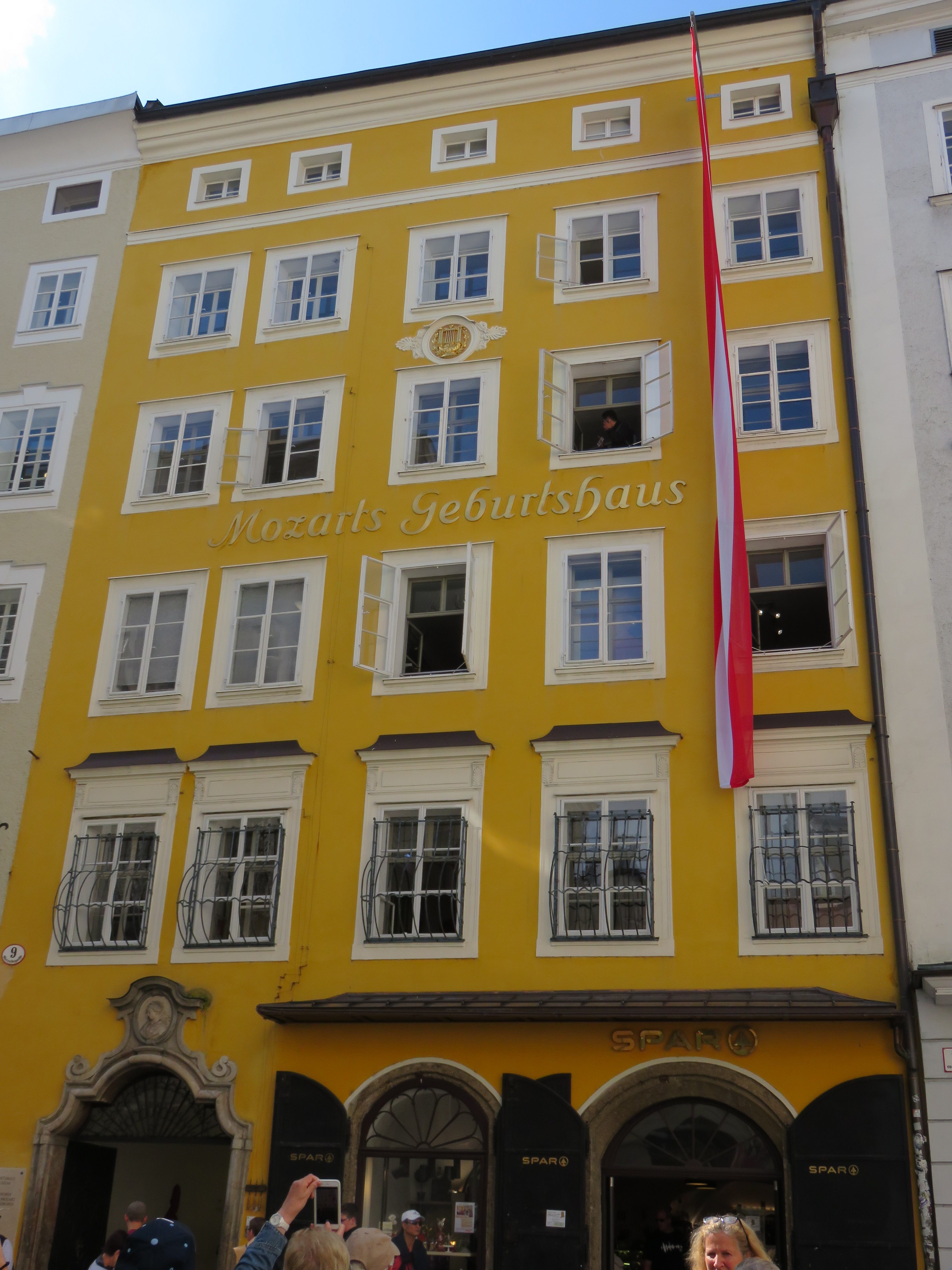
Wolfgang Amadeus Mozart was born here.
In Part 4: Neither the Prince of Liechtenstein or Heidi was around so instead we visited a mountain in Innsbruck and a centuries-old museum of Tyrolean farms.
SALZBURG, AUSTRIA
Where we stayed:
Imlauer Hotel Pitter Salzburg has been owned by the Pitter family since 2007. The hotel was renovated in 2014. It has a beer cellar and Imlauer Sky – Bar & Restaurant rooftop restaurant. The buffet was diverse and carries many regional dishes. Staff was friendly and professional.
What we saw:
One of my grandfathers was from Salzburg (which means salt fortress), so I was

The city of Salzburg, Austria stretches out alongside the Salza River.
intrigued by what I would see even before we arrived. Our local guide was funny, irreverent about some of history’s celebrities, and a fountain of information. One of the many places we stopped was an unimposing building where Wolfgang Amadeus Mozart was born. A plaque on the yellow exterior wall of Mozart’s Geburtshaus states that he was born in January 1756 and that the building is now a museum. We didn’t go in. Every tour group in Salzburg seemed to be either trying to photograph the building or lined up to enter, and the street just isn’t that wide! Next door was another signature place of birth: mathematician and physicist Christian Andreas Doppler, who formulated the principle of the Doppler effect. The Doppler effect states that the observed frequency of a wave depends on the relative speed of the source and the observer.
Mozart performed his first concert at age six for the Prince-Archbishop Wolf Dietrich Raitenau at Mirabell Palace. The palace was originally built for the Prince-Archbishop’s mistress, Salome Alt, in the 1600s. The manicured gardens were added in the early 1700s. The palace is a listed UNESCO World Heritage site, located in the city’s historic center.
If you are one of the diehard fans of “Sound of Music” then Salzburg is the place to visit, along with the other 300,000 fans who yearly pay homage. Not only did the real Maria live there (though Julie Andrews played her with much more innocent guile than the real Maria’s personality, we were told) in the Nonnberg Abbey, but many of the movie scenes were filmed on locations that are now pounced upon by flocks of tourists (and yes, there are actual “Sound of Music” tours). If you think we were any different from adoring fans, think again.
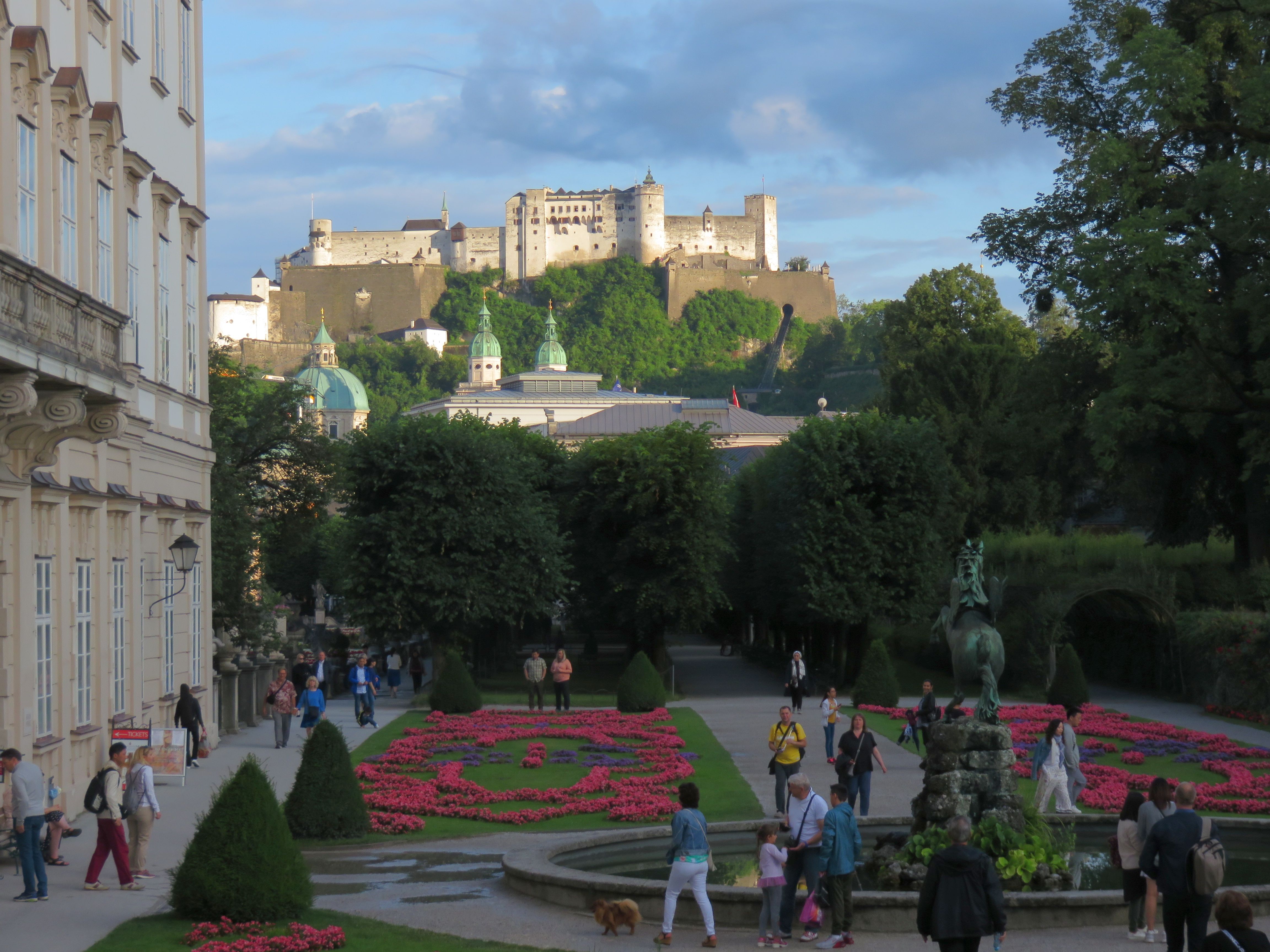
The gardens at Mirabell Palace.
I do have a sideways connection to Maria Von Trapp. My mom, Ellen Horn, was the VIP Coordinator (though unsure of the exact title) at Kennedy Space Center. She and Maria Von Trapp chatted each other up during one of the space launches and they remained pen pals. I also interviewed Robert Wise, director of the film, many years ago for a magazine and book, so I know a few inside stories from him. All of this translated to great curiosity and respect for what we were to see.
One of the first stops were the Pegasus Fountain and the steps where Maria and the children sing “Do-Re-Mi”. The steps are on the edge of the Mirabell Palace garden.
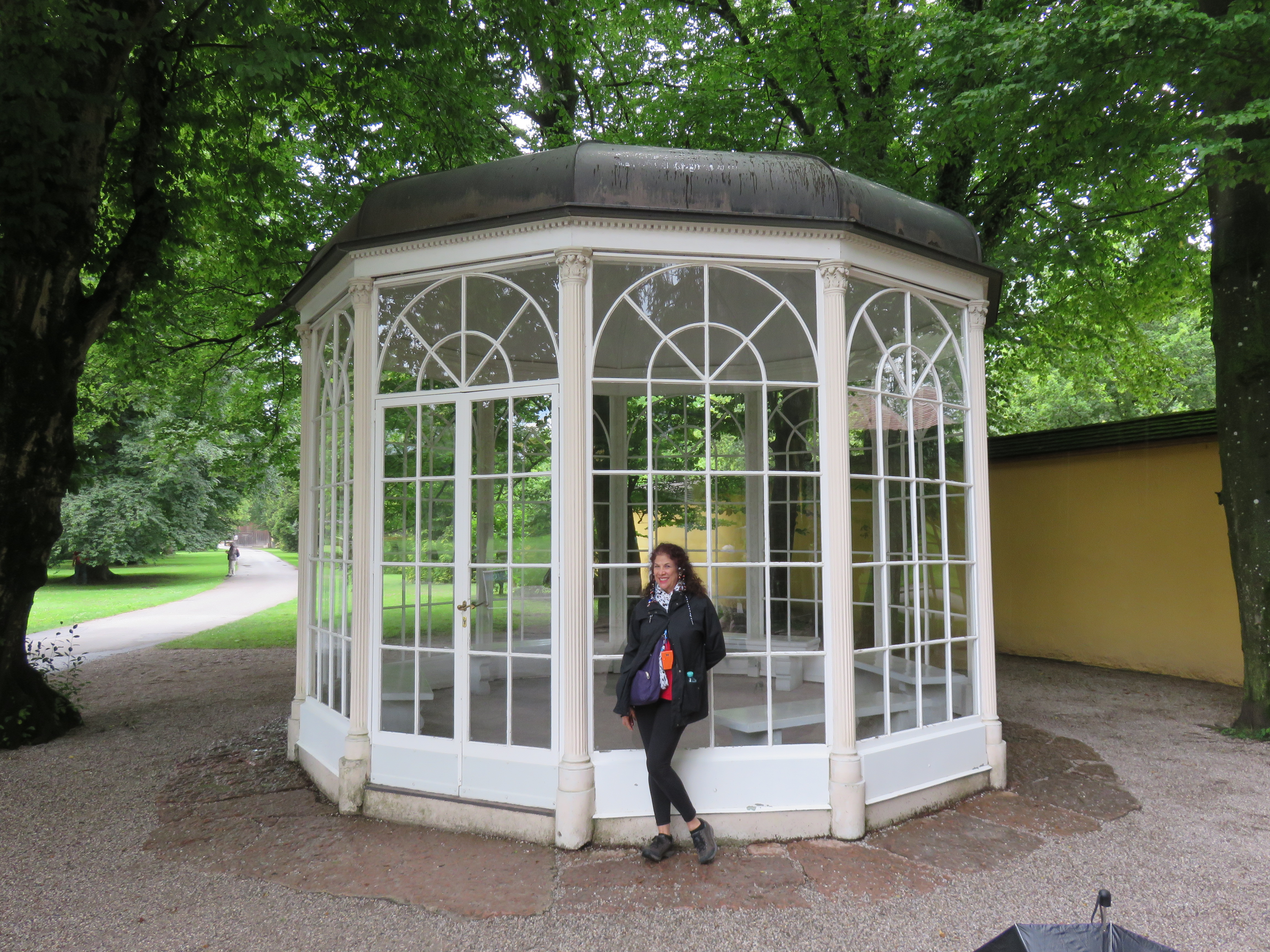
This the gazebo where several scenes from Sound of Music were filmed. It’s now at Hellbrunn Palace.
We then visited the gazebo where Liesl sings “16 going on 17”. Later in the film, Maria and the Captain sing “Something Good” in it. Today the gazebo sits on the grounds of Hellbrunn Palace. Originally it was built at Leopold Palace (as well a larger one just for filming ease). The original gazebo was gifted to Salzburg and remained at Leopold Palace until overzealous fans persisted on climbing over the palace walls to reach it. Restored, it was moved to Hellbrunn Palace, erected by Markus Sittikus as a pleasure palace, a popular concept around 1615 where parks, fountains and outdoor spaces were utilized for joyous gatherings, rest and relaxation. Hellbrunn is painted yellow. It has been referred to as the Month Palace because Sittikus made a bet that he could have it built in 31 days. It was.
We also passed by Residenz Square, site of the massive horse fountain where the Von Trapp family plays while Maria sings, “I Have Confidence in Me”. Later on, Nazi soldiers march through the square while their flag hangs above the entrance to the Old Residenz Palace.

The horse fountain in Residenz Square where Maria Von Trapp sang I Have Confidence In Me.
We learned quite a few juicy tidbits from our hasty stops, such as gender roles were often reversed for some of the characters. We were also informed that the beloved song, “Edelweiss” actually has no German or Austrian origins. It was written by Rodgers & Hammerstein specifically for the movie. Also, when the Von Trapp family fled after their last concert for the German high command, they were supposedly hiking to neutral Switzerland, located somewhere behind the musical theater (which is actually the Rock Riding School). In actuality, it would have been hundreds of miles to Switzerland. Leaving behind the theater would have led them directly to the Eagle’s Nest, Hitler’s mountaintop retreat. In the movie, the family hid in Saint Peter’s Cemetery where they were confronted by Rolf. They actually never hid in the cemetery.
From afar, we did see the red onion-domed Nonnberg Nunnery where Maria was a novice until she went to work for the Von Trapps.
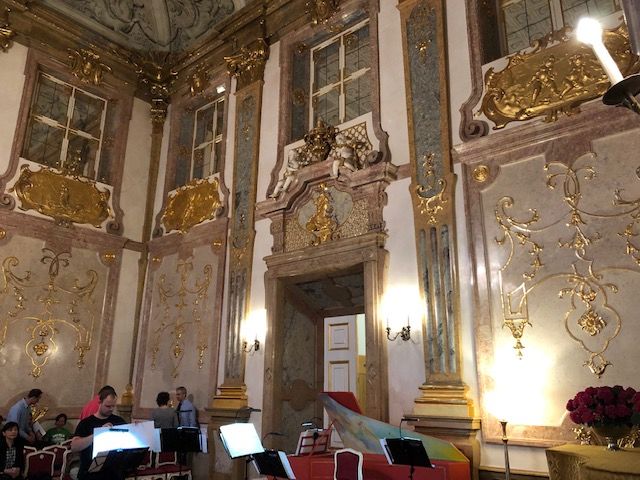
Schlosskonzerte Mirabell concert hall where Mozart gave his first concert at age 6.
Fortunately for us, we were in Salzburg when the Sunday evening classical concerts are held with the Ensemble 1756 in “Schlosskonzerte Mirabell,” the concert hall where Mozart gave his first performance at age six. The highly renowned classical ensemble puts its focus on the original interpretation of Mozart music using historical instruments. Thanks to Odysseys Unlimited’s advanced planning, our group occupied the two front-center rows for this Mozart-featured concert. The gilded room adorned with ornate moldings and cherubs was uncomfortably warm. Don’t forget, air conditioning had not yet been invented when this building was erected and likely cost-prohibitive to install now.
Dom zu Salzburg (Salzburg Cathedral) was built in 1628, is one of the most distinctive buildings in Salzburg, with two teal-colored domes and tower. It still contains the baptismal font in which Mozart, his sister Maria Ana, and Franz Xaver Gruber, who wrote the Yuletide song, “Silent Night” were baptized. An American WWII bomb fell through the central dome, but by 1959, renovations were completed. We weren’t able to hear any of the organ concerts, but this cathedral has five independent organs and two Italian pipe organs, so am sure the concerts are arousing.
We toured Hohensalzburg Castle, a fortress founded more than a 1,000 years ago, in 1077. We took the Festungsbahn funicular up 400 meters (about 1,312 feet), then passed through a tunnel into the main plaza. Heavy iron rings suspended from the tunnel’s rock ceiling were used by stationed soldiers to stow hanging buckets of water or to keep grains from vermin. The fortress stands high above the city and contains several administrative offices. Walkways are steep. Cafes border the outside walls, providing incredible views of the city below. About 40 people still reside within the fortress walls.
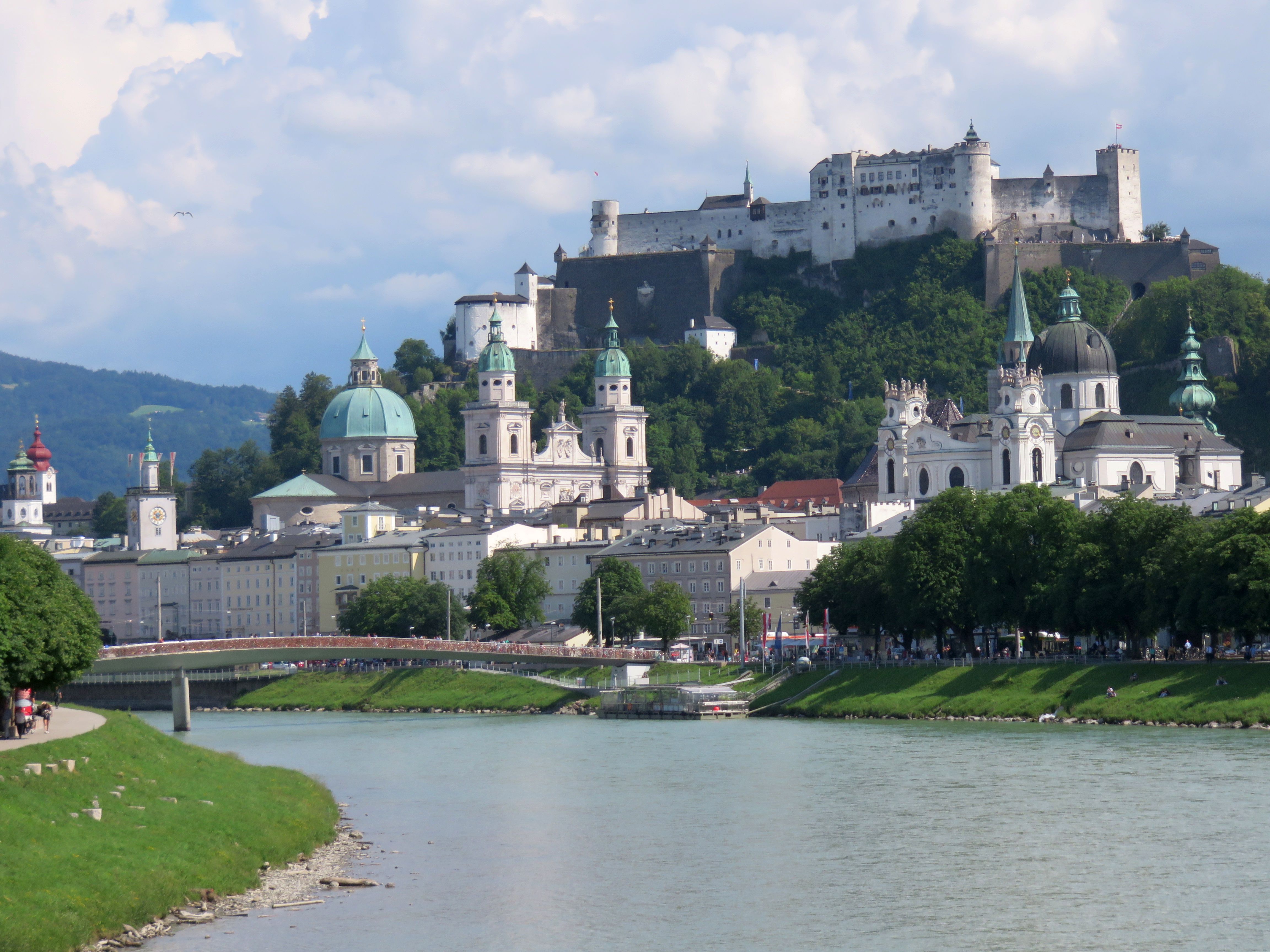
Hohensalzburg Castle, a fortress more than a 1000 years old.
We did peek into Kapelle St. Georgs (St. George’s Chapel) on the top level of the fortress, a UNESCO World Heritage site. When special events occur, the small chapel rings its bells. Depending on the duration of the bell chimes: 10, 20 or 30, the locals knows whether someone has been born, died, or been married. Catty corner from the chapel is a building where soldiers’ children attended school. It’s now used for summer artist residencies.
We took a quick peek into St. Peter’s Bakery, the oldest bakery in Salzburg. It was originally built as a grain mill for St. Peter’s Monastery and recycled into a bakery in the 12th century. We stepped down rocky stairs into a fairly dark, small room just off where bakers still produce aroma-enticing fresh loaves of sour dough and pumpernickel breads on the original wood-fired oven. An old water mill located outside the bakery once supplied all its water.

Imposing Salzburg.
What we learned:
The population of Salzburg is roughly 155,000.
Salzburg native son Wolfgang Amadeus Mozart was only 35 when he died but in that time he composed 600 pieces of music. He could hear a musical composition once and then could replicate it precisely. At age five, he watched his father’s friends play violin. He picked up a violin and began accompanying them expertly. It was also the age he is credited with writing his first composition, “Twinkle, Twinkle, Little Star”. Last summer, when my husband Russ and I visited parts of Hungary and Austria on an Eastern European tour with Odysseys Unlimited, we heard a lot about Maria Theresa, who was the only woman ruler in the 650 years of the Hapsburg Dynasty. Of her many accomplishments during her reign from 1740-1780, such as fighting for the rights of women and initiating a system of numbering addresses, she bore 16 children. As we were in Austria, stories about Maria Theresa kept cropping up into conversations about royal history.
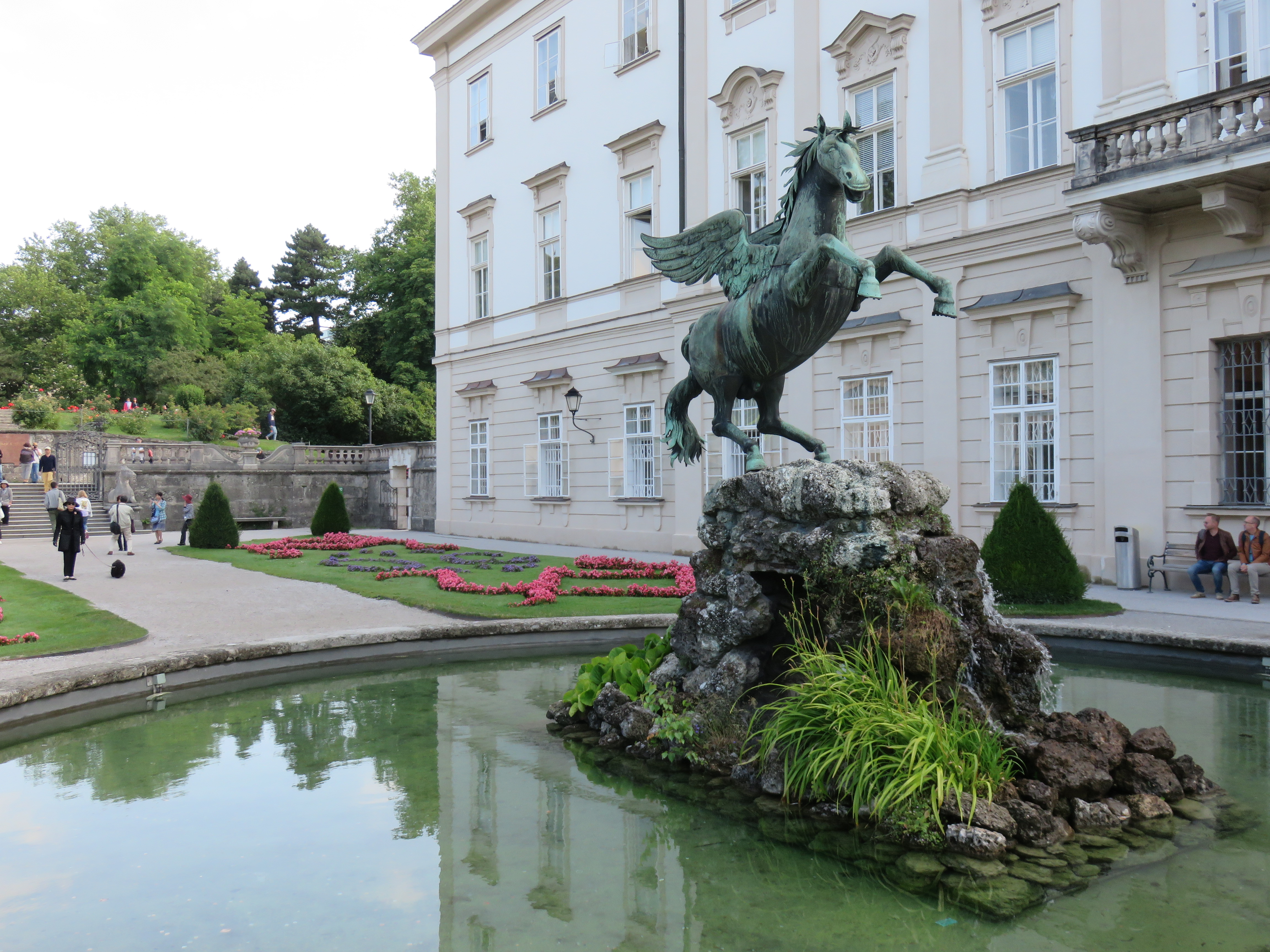
The beauty of Mirabell’s flowers and statuary.
On this trip, we heard she had invited Mozart to her summer palace in Vienna when he was just six. The story goes that he jumped into her lap, then ran away and fell in the hallway. The Queen’s youngest daughter saw him, picked him up, and consoled him. He thought her beautiful and said someday he would marry her. He never got the chance. Her name was Marie Antoinette! (Yes, the “let-them-eat-cake queen who was beheaded in October 1793.)
Mozart was influenced by Antonio Vivaldi. Like Mozart, he also went to Vienna to seek his fortune. Neither succeeded during their lifetimes. Both ended up being buried in pauper graves.
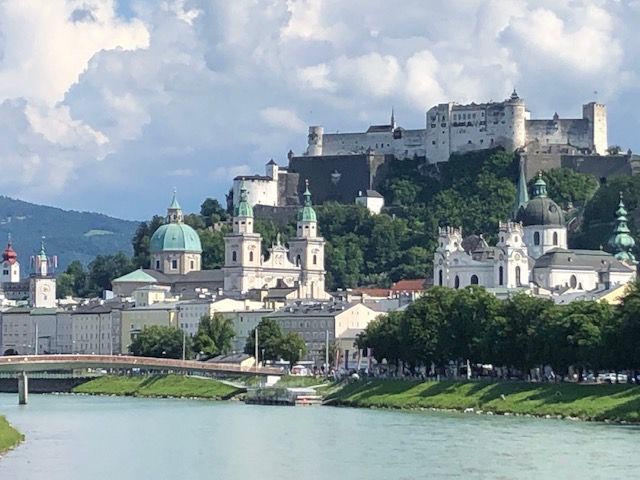
Salzburg sits high and proud over the Salza River.
In 1683, after the Turks had invaded and fled, they left behind bags of coffee beans. Georg Franz Kolschitzky, a hero during the Siege of Vienna and who had acquired a fondness for Turkish coffee, asked for and received bags of coffee beans as a reward. Needing an income, he opened the first coffee shop in all of Europe, in Vienna. The success of his venture led to a street in Vienna’s 4th district being named after him.
When you see a sign in Austria consisting of a circle with a spread out hand and the word, falsch, it means stop.
There are a fair number of beggars who prostrate themselves on the streets or in doorways of churches. They are usually Romanian or Bulgarian and generally part of a band of gypsies.
Salzburg is divided by the Salzach River. Strict environmental laws protect the river and keep it clean.
Rubber ducks are popular in Austria and Germany and Russ had to have one of these Mozart ducks.
Part of a local woman’s apparel in Salzburg is an apron. How the bow is tied reveals her marital status. If on the right, it means she is married. On the left, looking for love. Young girls tie theirs in the middle front.
Ironwork signage above storefront entrances is prevalent, usually denoting the establishment’s business.
Although most Austrians are Roman Catholic, they are not necessarily religious.
Where and what we ate and drank:
Our hotel’s Imlauer Sky – Bar & Restaurant provided one of our group dinners. It began with smoked salmon, beef tartar, and cheeses. Russ and I both had the chicken with scalloped potatoes, which we enjoyed as heartily as those who enthused about the other entrée of prawns and pasta.
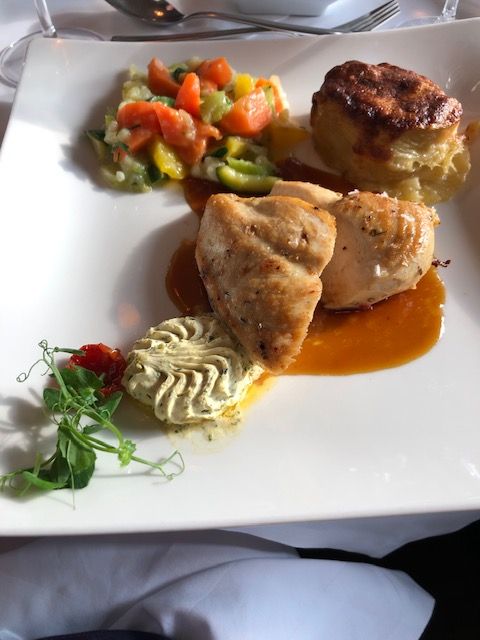
Chicken with scalloped potatoes at Imlauer sky-Bar & Restaurant.
Thanks to confectioner Paul Fürst’s baking skills, sweet tooth, and strong admiration for Mozart, Salzburg is the 1890 birthplace of the famous Mozartkugel (Mozart balls), a small, round ball of layered pistachio, marzipan and nougat, covered in dark chocolate. Originally known as Mozart-Bonbon, the confection won him a gold medal at the Paris Exhibition in 1905. We had the fortune of sitting in his original pastry shop, Café Fürst Konditorei, established in 1884, for a genuine Mozart ball and a coffee. The balls are decadently rich! They’re sold across Austria, but here’s what you need to know. Handcrafted ones are wrapped in blue and silver foil. Commercial ones are wrapped in red and gold.
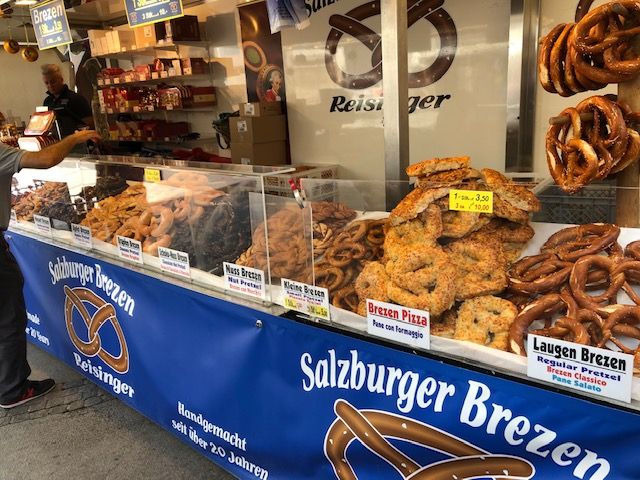
Ever-prevalent pretzels come in every size and flavor.
Russ, tour friends Brian and Carol Moyer, and I decided to have a light lunch at Panoramarestaurant zur Festung Hohensalzburg. The food was far less of a draw than the spectacular views, especially on the bright sunny day we were having. I mean seriously: how many opportunities can one have to sit on the wide ramparts of a 1,000+ year-old castle’s walls and overlook an entire city? We shared traditional soft pretzels and wine. Russ and I also had a small salad and a sausage plate.
BERCHTESGADEN, GERMANY
What we saw:
The trip to the Bavarian resort town of Berchtesgaden and the site of the clifftop Kehlsteinhaus (Eagles’ Nest) was a short coach ride away from Salzburg. The reception area for the Eagle’s Nest tour has free restrooms, large bookstore and gift shop. We waited for our scheduled time to ride 20 minutes on a special bus capable of scaling the twisted, steep mountain road to the 6,000-foot-high summit. Built between 1937 and 1938, the road is seven km (4.35 miles) long. We passed through five tunnels. Bus seating is limited and tickets are carefully scrutinized for the booked time. Following the bus ride, we walked through a long, chilly tunnel to reach the original brass elevator that Adolf Hitler built to carry he and his Nazi officials to the alpine retreat. The expensive elevator interior is bright yellow gold. The original telephone, clock and light fixtures are preserved intact.

One of the five tunnels you pass on climb to Hitler’s Eagle’s Nest.
The chalet, where his girlfriend Eva Braun stayed while Hitler came and went, was used for entertaining purposes. Her own sister was married in the chalet to a military man. He later deserted and was executed on Hitler’s orders. Many of his military leaders and their families lived in Berchtesgaden to make it convenient for the leaders to ascend to the Eagle’s Nest compound for meetings. Some executed their own families when it was obvious the allies were nearing and the war effort was lost. Eva met Hitler when she was 17 and he was 40. The chalet, now a restaurant, contains many of the pictures she had taken as a photographer experienced in 16m color. Her photos of daily activities and the visitors who frequented Eagle’s Nest have proven to be valuable historical documentation.
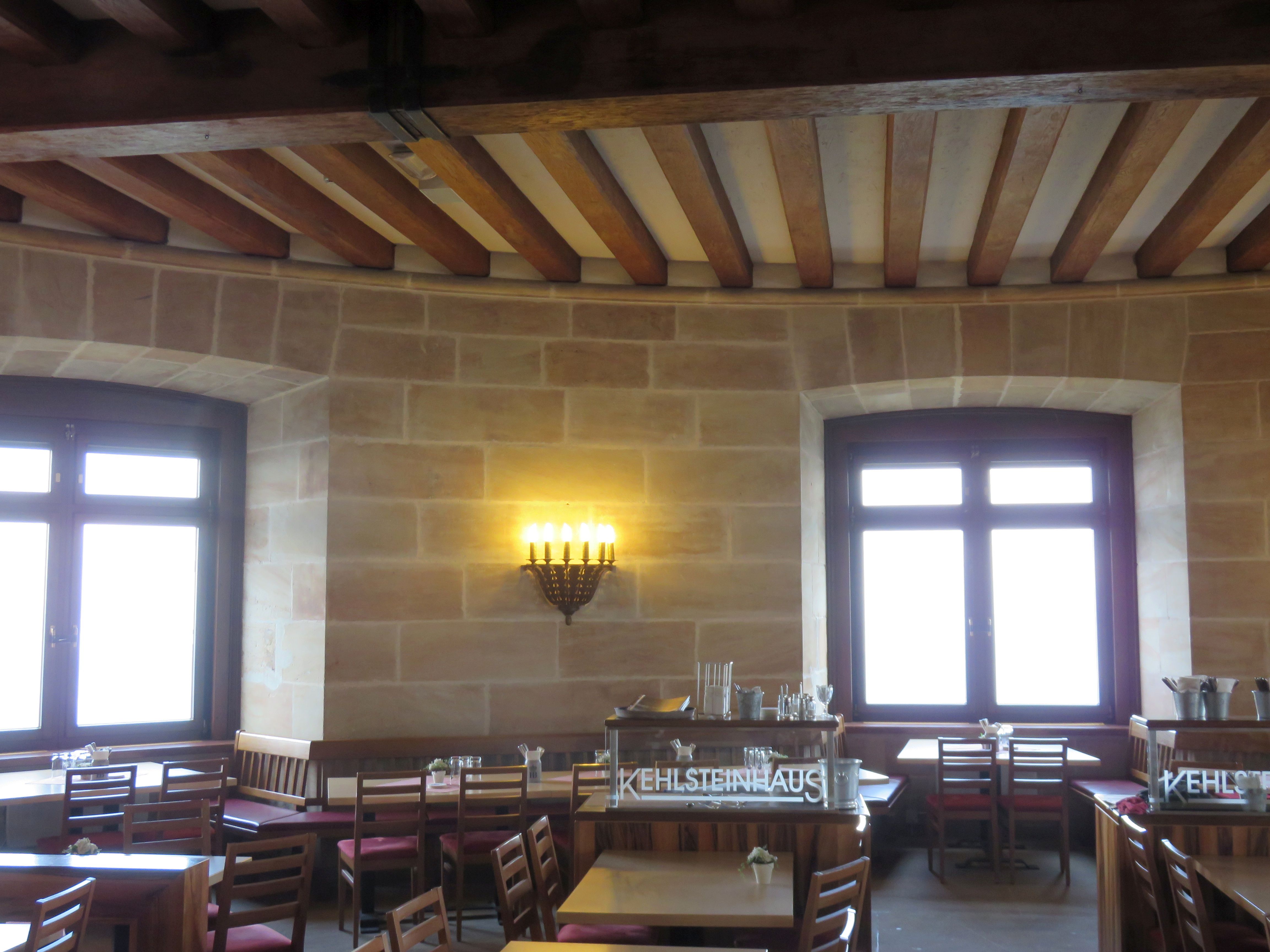
The chalet at Eagle’s Nest was used for entertaining and is now a restaurant.
What we learned:
The Eagles’ Nest chalet was given to Hitler as a 50th birthday present. Until the 101st Airborne captured the enclave, the fortress remained impregnable throughout World War II. Before named the Supreme Leader, he had attended art school in Munich. He joined the National Socialist Workers party (Nazis), becoming their leader quickly. The party had its own private army: the brown shirts. He wrote Mein Kampf while jailed for trying to overthrow the government. He warmed up his extermination plans in concentration camps by gassing disabled Germans. The 1929 depression helped boost him into power as Chancellor. When the Reichstag, home to the German parliament, burned down February 27, 1933 (suspected to be arson by the Nazis), it became the catalyst for Hitler’s power grab. He then installed all his friends into strategic positions.
Hugo Boss designed the Nazi uniforms.

The outside patio of Eagle’s Nest chalet offers strategic views.
The same company that manufactured a deadly gas for the concentration camp showers was later used to deter the growth of lichen on the memorial stones erected in Berlin to honor the Jew murdered in the Holocaust. When discovered that it was the same company, the chemicals were removed from the memorial stones. If you want to read more about the Jewish memorial stones, click on this link. https://karenkuzsel.wordpress.com/2018/09/27/part-7-eastern-europe-strudel-schnitzel-and-strauss-a-few-of-our-favorite-things/
The Eagle’s Nest had been a thriving village until Hitler ousted everyone and took it over for himself and his executive supporters. It quickly became the second seat of Nazi power. In 1938, leaders from Germany, Great Britain, France and Italy signed the Munich Treaty, which permitted German annexation of the Sudetenland in western Czechoslovakia. Many celebrities came to the Eagle’s Nest compound to party, such as Wallis Simpson and Britain’s Edward III, who sought favors that would return him to the throne he had abdicated. Eva Braun and Adolf Hitler married less than 40 hours before committing suicide by ingesting cyanide in the bunker underneath the Chancellery building in Berlin.
We heard an Austrian phrase repeated several times on this trip due to our better-than-predicted weather: When angels travel, the sun shines.
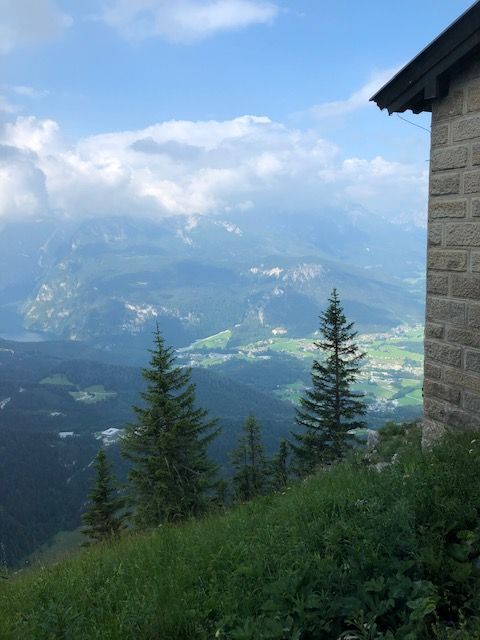
The view from Eagle’s Nest stretches across miles.
While sitting at Symphonie Restaurant, across the Salzac River from the Capuchin Monastery for our final group dinner, our incredibly knowledgeable Tour Director W relayed the legend of cappuccino coffee’s humble beginnings. A coffee maker had created a new beverage to be served hot in a glass, with frothy milk on top of black coffee. He needed a name. He noticed the Capuchin monks’ black habits with white capes, and now you know where cappuccino coffee may have been born!
Where and what we ate and drank:

Gasthaus Cafe Graflhoehe Windbeautelbaron has great views and even better food.
After our tour of the Eagle’s Nest, we stopped for lunch in Berchtesgaden at Gasthaus Cafe Graflhoehe Windbeutelbaron, a wonderfully authentic German restaurant hanging over a cliff. This meal was outstanding. I regretted later that I had limited devouring my lunch, concerned that our evening included another large group meal. Russ and I both had chosen the weinerschnitzel, one of the best we’ve ever had. It was lightly battered, fluffy and not over fried. It came with roasted potatoes (the predictable but always delicious rosti), and a side salad with shredded carrots, cabbage, tomatoes etc. We had been verbally prepped for the dessert, signature to the restaurant and quite famous in the area. Der Windbeutel is a giant puff pastry filled with Morello cherries, cream, and vanilla ice cream. I did try a tiny taste of the components, but just couldn’t eat more after the incredible meal we’d just had. (Note: The final group meal was disappointing. I’ve learned the venue will likely not be used going forward, so have decided to eliminate it from the review.) I wish I’d eaten more of my outstanding lunch.
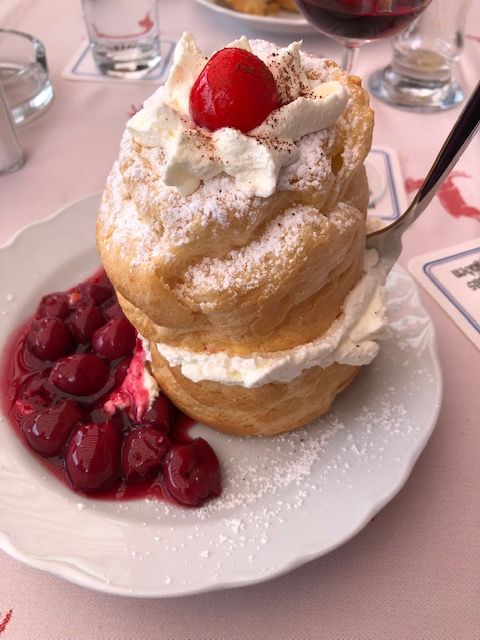
Der Windbeutel is the house special of puff pastry, cream and vanilla ice cream.
Our Alpine Splendor trip was complete, but Russ and I, along with two other couples from our group, were embarking on an extension trip to Munich, Germany.
In Part 6: The vacation ends in the proud city of Munich, where Olympics have been held, fairytale castles are built, and beer gardens bring together families and tourists alike.
Karen Kuzsel is a writer-editor based in the Orlando area who specializes in the hospitality, entertainment, meetings & events industries. She is an active member of ILEA and MPI and is now serving on the 2019 – 2020 MPI Global Advisory Board for The Meeting Professional Magazine for the fourth consecutive year. She is a member of the Society of Professional Journalists. Karen writes about food & wine, spas, destinations, venues, meetings & events. A career journalist, she has owned magazines, written for newspapers, trade publications, radio and TV. As her alter-ego, Natasha, The Psychic Lady, she is a featured entertainer for corporate and social events. karenkuzsel@earthlink.net; www.ThePsychicLady.com; @karenkuzsel; @thepsychiclady. Food photos for this series by Karen Kuzsel. All other Photos by Russ Wagner, a retired government planner/builder who has a passion for trains, travel and taking photographs.
www.imlauer.com/en/hotels/hotel-pitter-salzburg/
www.salzburg.info/en/sights/top10/mirabell-palace-gardens
www.salzburg-palace-concerts.com
www.salzburg.info/en/sights/churches-cemeteries/salzburger-cathedral
www.gcatholic.org/churches/europe-west/46508.htm
www.salzburg.info/en/dining-shopping/traditional-businesses/stiftsbaeckerei-st-peter
www.original-mozartkugel.com/index_e.php
www.salzburg.info/en/travel-info/infos/

Leave a Reply
Want to join the discussion?Feel free to contribute!